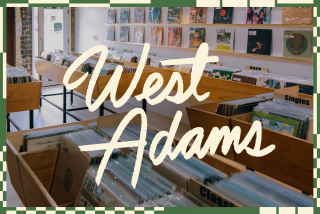Powerful Place Called Home
- Share via
Boyle Heights is known this time of year for its nacimientos, the homemade Nativity scenes that festoon lawns and living rooms. Part folk art, part family album, the elaborate dioramas are a tradition transplanted from Mexico to this neighborhood just east of downtown Los Angeles. They are a particularly fitting symbol for an area that has long been a refuge for wanderers in search of welcome.
“Boyle Heights: The Power of Place,” a multimedia exhibit at the Japanese American National Museum in downtown’s Little Tokyo, recounts that history. At the turn of the last century, the neighborhood, one of the city’s first, was home to blacks from the South and Jews from the Midwest. Japanese Americans flocked there after the 1906 San Francisco earthquake. Mexican immigrants came fleeing civil strife and revolution. Molokans, a dissenting sect of the Russian Orthodox Church, escaped persecution to settle east of the Los Angeles River in an area still known as the Russian flats.
They came to Boyle Heights because it didn’t have the racially discriminatory housing covenants increasingly common in newer neighborhoods. Consequently, it became the most diverse area in Los Angeles from the 1920s through the 1950s, home to Molokan congregations, Buddhist temples, synagogues and that holiest of places, Canter’s Deli, until it moved to the Fairfax District.
Home-grown music of the era, which visitors can hear through headphones at the museum exhibit, includes mariachi, for which Boyle Heights is still famous, but also taiko, or Japanese drumming, and swooning klezmer clarinets. The mix yielded such hits as Little Julian Herrera, East L.A.’s first rhythm and blues star, born Ron Gregory of Hungarian and Jewish parents, adopted and raised by a Latino family and discovered by R&B; giant Johnny Otis.
Boyle Heights was not inviolate. In the 1930s, the U.S. government deported Mexican immigrants viewed as taking scarce Depression-era jobs. After the Japanese bombed Pearl Harbor in 1941, the government ordered Japanese Americans held in camps; enrollment at Theodore Roosevelt High School dropped by one-third as local families gave up homes and businesses. In 1943, U.S. servicemen rampaged through Boyle Heights, attacking Mexican Americans in what became known as the Zoot Suit riots. After the war came the freeways, taking 10% of the neighborhood’s land and uprooting 10,000 residents.
Still, the Boyle Heights of today survives as a refuge. Some of its more recent residents fled war zones or hard economic times in Central America and Mexico. In decorating their homes this season, they tell a story as old as Bethlehem and as new as Los Angeles.
*
“Boyle Heights: The Power of Place” runs through Feb. 23, 2003, at the Japanese American National Museum, 369 E. 1st St. On Jan. 5 from 1 to 5 p.m., the Latino Urban Forum is sponsoring a self-guided tour of nacimientos. Download a map at www.therare times.com or call (213) 629-9122.
More to Read
Sign up for Essential California
The most important California stories and recommendations in your inbox every morning.
You may occasionally receive promotional content from the Los Angeles Times.










